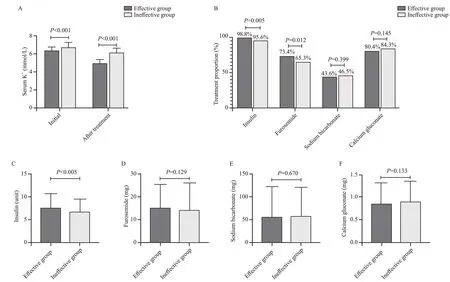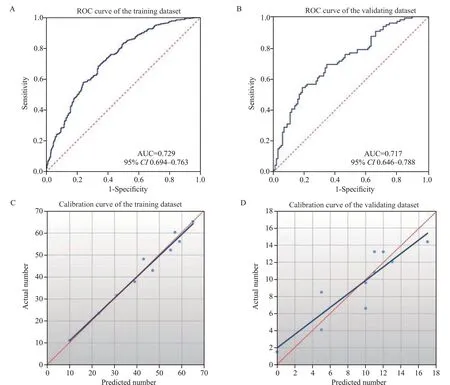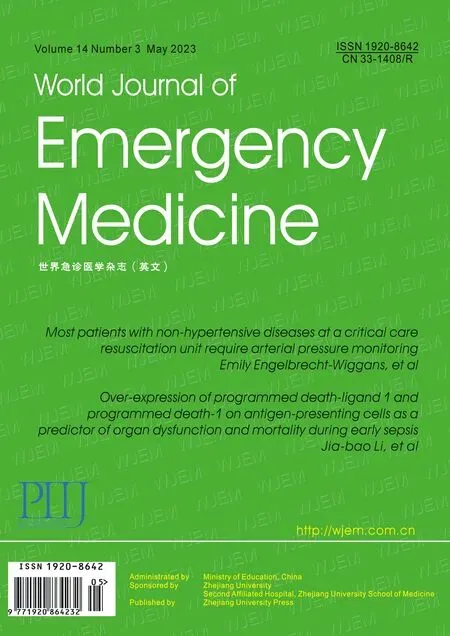Development and validation of a predictive model for the assessment of potassium-lowering treatment among hyperkalemia patients
Cong-ying Song, Jian-yong Zhu, Wei Huang, Yuan-qiang Lu
1 Department of Emergency Medicine, the First Affiliated Hospital, School of Medicine, Zhejiang University, Hangzhou 310003, China
2 Key Laboratory for Diagnosis and Treatment of Aging and Physic-chemical Injury Diseases of Zhejiang Province,Hangzhou 310003, China
KEYWORDS: Hyperkalemia; Predictive model; Potassium-lowering treatment; Therapeutic outcome
INTRODUCTION
Hyperkalemia is a potentially life-threatening medical condition with an adverse prognosis, which requires early recognition and treatment.It is more common in patients with renal dysfunction, heart failure, and with recent use of certain medications that can increase the level of serum potassium (K+), such as angiotensin-converting enzyme inhibitors (ACEIs), angiotensin receptor blockers (ARBs),β-adrenergic receptor blockers, nonsteroidal antiinflammatory drugs (NSAIDs), and digoxin.[1]In most cases, severe hyperkalemia requires immediate treatment due to its electrophysiological effects.Meanwhile,hyperkalemia can be challenging to manage: the types of potassium-lowering drugs, the dosage of drugs, and the time points of choice for hemodialysis treatment are all inconclusive.[2]A good approach for adjusting the drug dosage would be an early response assessment after the first round of potassium-lowering treatment.Due to a lack of prediction methods for the efficacy of potassiumlowering treatment, the drug dosage adjustment is quite difficult.Therefore, in this study, we aimed to develop a predictive model to evaluate the efficacy of potassiumlowering treatment and provide benefits for therapeutic decision-making.
METHODS
Study design and population
The study was conducted in accordance with the Strengthening the Reporting of Observational studies in Epidemiology (STROBE) guidelines for cohort studies.We included patients with hyperkalemia in the First Affiliated Hospital of Zhejiang University from January 1, 2015, to June 30, 2021.Patients who met the following criteria were excluded: (1) patients with shock; (2) patients with age ≤18 years; (3) pregnant patients; and (4) patients with important information deficits.Hyperkalemia was defined as serum K+≥5.5 mmol/L.Repeat serum K+determinations were performed within 2–4 h of the initial examination.A retested serum K+level after the first round of potassium-lowering treatment that decreased to less than 5.5 mmol/L was defined as an effective treatment.Patients were divided into the effective treatment group and the ineffective treatment group according to the retested serum K+.In the first round of potassium-lowering treatment, only drugs were used in our department.Insulin dissolved in glucose solution was the most commonly used treatment.Furosemide or other loop diuretics were given to accelerate the potassium excretion, and calcium gluconate was given to protect the heart.Sodium bicarbonate was usually used if the patient had acidosis.
Data collection
The patients were randomly divided into training dataset(80%) or validating dataset (20%) using a computerized random sampling program in SPSS.Patient data were collected from the electronic medical record in the First Affiliated Hospital of Zhejiang University.Demographic variables, including age and sex, clinical symptoms,comorbidities (diabetes mellitus, hypertension, chronic liver disease, rheumatism, tumor, and chronic renal disease),and history of recent use of hyperkalemia-related drugs,including ACEIs, ARBs, β-blockers, NSAIDs, and digoxin,were collected to identify the factors that could influence serum K+.Laboratory data, including routine blood count,biochemical indicators of liver and kidney function, and blood gases, were all first recorded after administration.Serum K+levels were recorded before and after the first round of potassium-lowering pharmacotherapy.Drug dosage was standardized: 4 to 6 units insulin, 20 mg furosemide, 1 mg calcium gluconate, or 125 mg sodium bicarbonate were recorded as one treatment unit.
Statistical analysis
All statistical analyses were performed using the SPSS statistical software package (version 25.0).Descriptive characteristics were presented as medians with interquartile ranges (IQR) for continuous variables and numbers with percentages for categorical variables.Continuous data were evaluated using the Mann-WhitneyU-test, and categorical variables were evaluated by the Chi-square test.To identify independent risk factors, we performed multivariate logistic regression analyses with a forward stepwise method, and multicollinearity was assessed through the variance inflation factor (VIF) before regression.The discrimination capacity of the predictive model was assessed by calculating the area under the receiver operating characteristic (ROC) curve.The calibration capacity was evaluated by the Hosmer-Lemeshow test.Data were considered statistically significant at aP-value <0.05.
RESULTS
Baseline characteristics of participants in the training dataset
A total of 818 elderly participants were enrolled in the training dataset, including 429 patients in the effective group and 389 individuals in the ineffective group.There were no significant differences in sex between the two groups (Table 1).Patients in the effective group were younger than those in the ineffective group (63.0[52.0–74.5] years vs.67.0 [55.0–77.0] years,P=0.007).A higher percentage of patients in the ineffective group had peripheral edema (34.2% vs.20.7%,P<0.001) or oliguria(24.2% vs.14.7%,P=0.001).The initial serum K+level was higher in the ineffective group than in the effective group (6.6 [6.3–7.0] mmol/L vs.6.3 [6.1–6.6] mmol/L,P<0.001) (Figure 1A).Dextrose fluid mixed with insulin was the most commonly used treatment in hyperkalemia patients, while the percentage of insulin usage was higher in the effective group than in the ineffective group (98.8%vs.95.6%,P=0.005).A higher percentage of patients in the effective group received furosemide (73.4% vs.65.3%,P=0.012).Calcium gluconate was used in 80.4% of patients in the effective group and 84.3% in the ineffective group (Figure 1B).Almost all the laboratory results showed no significant differences between the two groups(Table 1).
Development of the predictive model
Based on the primary analyses, we selected parameters with aP-value <0.05 in multicollinearity assessment with VIF before multivariate logistic regression analysis.There was no multicollinearity among the variables (all VIF values<10, supplementary Table 1).After regression analysis by using the forward stepwise method, age (P=0.001),peripheral edema (P<0.001), oliguria (P=0.050), history of kidney transplantation (P=0.001), ESRD (P=0.016), insulin(P<0.001), and initial potassium (P<0.001) were identified as independent predictors for the therapeutic effect of potassium-lowering treatment (supplementary Table 2).The following equation was derived:
logit(P)=10.626 – 0.015×age – 0.704×peripheral edema – 0.399×oliguria – 0.955×history of kidney transplantation – 0.450×ESRD + 0.515×insulin –1.504×initial potassium; P means the probability of effective potassium-lowering treatments.
Validation of the predictive model
The developed predictive model was evaluated in the training dataset (n=818) and validating dataset (n=196).The discrimination of the model was valued by using ROC analysis, and the area under the curve (AUC) in the training dataset was 0.729 (95% confidence interval[95%CI] 0.694–0.763) and 0.717 (95%CI0.646–0.788)in the validating dataset (Figures 2 A-B), which suggested that the predictive model had good performance.The calibration curve of the model demonstrated good agreement between prediction and observation in the training dataset and validating dataset (Figures 2 C-D).The Hosmer-Lemeshow test suggested that there was no departure from perfect fit (P=0.870 in the training dataset,P=0.220 in the validation dataset).
DISCUSSION
The main finding of this study is that age, peripheral edema, oliguria, history of kidney transplantation, ESRD,insulin, and initial potassium were all independently associated with favorable treatment Effects, which could be used as factors for predicting treatment effects in patients with hyperkalemia.Patients with hyperkalemia who were older, had renal dysfunction or higher initial serum K+, and received lower doses of insulin were prone to have an ineffective therapeutic effect after the first round of potassium-lowering treatment.
Hyperkalemia is one of the most serious electrolyteabnormalities in the clinic since it can cause severe electrophysiologic disturbances.[1]A retrospective study of 932 hospitalized patients suggested that the rates of arrhythmia (35.2%) and cardiac arrest (43.3%) in patients with serum K+levels >6.5 mmol/L were quite high.[3]Researchers found that patients with serum K+>5.1 mmol/L had an increased duration of hyperkalemia and mortality.[4]Another study showed that critically ill patients with hyperkalemia had higher mortality, and it was considered an independent predictor of death.[5]
Due to renal dysfunction in potassium homeostasis,hyperkalemia is common in patients with chronic kidney disease (CKD).[6]Some drugs that are beneficial to patients with CKD, such as renin-angiotensinaldosterone-system antagonists, are also the common causative or contributing factors of hyperkalemia.[7]Hyperkalemia has been shown to be associated with increased mortality in patients with CKD, especially in ESRD patients on maintenance hemodialysis or in kidney transplant recipients, emphasizing the importance of maintaining serum K+levels in the physiologically normal range.[8,9]In our study, we found that renal disease, including histories of kidney transplantation,chronic renal disease, and ESRD, were all risk factors for adverse outcomes after potassium-lowering treatment.In addition, patients with peripheral edema or oliguria were also prone to have ineffective outcomes, and these symptoms might also suggest renal dysfunction.[10]
The main therapeutic methods for hyperkalemia include: (1) shifting serum K+from the extracellular to the intracellular cell; (2) accelerating the excretion of K+from the body; and (3) stabilizing the potential in the myocardium.Among these treatments, dialysis may be the most effective method of lowering serum K+, by removing potassium from the blood with the dialysate and shifting potassium from the extracellular to the intracellular compartment as the acidosis is reversed.[11,12]However, a long preparation period is required before patients can receive hemodialysis.Thus, drug treatments are required before hemodialysis.Insulin can lower plasma potassium levels by promoting K+entry into cells.[13,14]Among these types of potassium-lowering treatments, we found that insulin was the only independent predictor of the therapeutic effect, suggesting that insulin may be the most effective potassium-lowering drug in the emergency treatment of hyperkalemia patients before hemodialysis.

Figure 1.Treatments of hyperkalemic patients.A: serum potassium levels of hyperkalemic patients between the effective and ineffective groups;B: proportion of patients receiving each therapeutic regimen; C-F: the dosages of insulin, furosemide, sodium bicarbonate, and calcium gluconate used for hyperkalemic patients in the effective and ineffective groups.
Using the predictive model we developed, clinicians may adjust the drug dosage based on the predicted effect of potassium-lowering treatment.If the predictive model suggests that the probability of potassium dropping to the normal range after the first round of pharmacotherapy is very low (<50%), clinicians should start a second round of potassium-lowering treatment and prepare the patient for dialysis.Rapid detection and intervention of hyperkalemia are crucial for preventing serious complications.[15]
There are also limitations in our study.First, this was a retrospective cohort study, and there might be some residual confounding.Therefore, we increased the sample size to reduce the error.Second, because the exact time interval between the two serum K+tests was difficult to obtain, the time-effect relationship could not be determined.Each repeated serum K+determination was performed within 2–4 h of the initial examination.Finally, this was a single-center study; to make the sample more representative and to optimize the model,we plan to conduct research in multiple centers.
CONCLUSIONS
Patients with hyperkalemia who were older, had renal dysfunction or higher initial serum K+, and received lower doses of insulin, were prone to have an ineffective therapeutic effect after the first round of potassiumlowering treatment.The developed predictive model could provide early prediction of therapeutic outcomes for hyperkalemic patients receiving potassium-lowering treatment, which could also help clinicians identify highrisk hyperkalemic patients and adjust the dosage of potassium-lowering medication.

Figure 2.Validation of the predictive model for assessing the effect of potassium-lowering treatment.A, B: ROC curve of the predictive model; the AUC showed that this predictive model had a quite good discriminative capacity; C, D: calibration curve of the predictive model.The Y-axis represents the actual number of patients with effective potassium-lowering treatment; the X-axis represents the predicted number of patients with effective potassium-lowering treatment.The orange line represents a perfect prediction by an ideal model.The blue line represents the performance of the novel model, of which a closer f it to the orange line represents a better prediction.ROC: receiver operating characteristic; AUC: area under the curve; 95% CI: 95% confidence interval.
ACKNOWLEDGEMENTS
We would like to thank Wen Fang (the First Affiliated Hospital, School of Medicine, Zhejiang University,Hangzhou, China) for providing assistance with language editing.
Funding:This research was supported by the Key Research and Development Program of Zhejiang Province (2019C03076).
Ethical approval:This study was approved by the Ethical Committee of the First Affiliated Hospital, School of Medicine,Zhejiang University (2022971).Written informed consent was obtained from each patient or his/her authorized representatives following a full explanation of the study.All methods and procedures in this study were carried out in accordance with relevant guidelines and regulations.
Conflicts of interest:The authors declare that they have no competing interests.
Contributors:CYS and JYZ contributed equally to this work.YQL conceived and designed the experiments.JYZ and CYS collected and analyzed the data.CYS and WH contributed to the writing of the manuscript.JYZ and YQL revised the manuscript.
 World journal of emergency medicine2023年3期
World journal of emergency medicine2023年3期
- World journal of emergency medicine的其它文章
- A 94-year-old patient with severe burns: a case report
- Pregnancy-related spontaneous coronary artery dissection after intravenous ritodrine infusion: a case report
- Twelve family members with tetramine poisoning after consumption of vegetables grown in polluted soils
- Resuscitative endovascular balloon occlusion of the aorta in the treatment of severe hemorrhagic shock caused by upper gastrointestinal bleeding
- A rare case of purulent pericarditis secondary to subdiaphragmatic abscess
- Laryngeal mask airway bougie ultrasonography guided intubation in a morbidly obese patient with difficult airway
